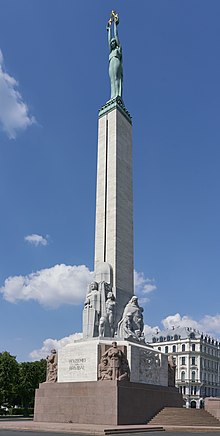
Back نصب الحرية (ريغا) Arabic Azadlıq abidəsi Azerbaijani Азатлыҡ һәйкәле Bashkir Статуя Свабоды (Рыга) Byelorussian Помнік Свабоды (Рыга) BE-X-OLD Паметник на свободата (Рига) Bulgarian Monument a la Llibertat Catalan Pomník svobody Czech Frihedsmonumentet (Riga) Danish Freiheitsdenkmal (Riga) German
| Freedom Monument Brīvības piemineklis | |
|---|---|
| Riga Monument Agency Rīgas Pieminekļu aģentūra | |
 | |
| For Heroes killed in action during the Latvian War of Independence | |
| Unveiled | 18 November 1935 |
| Location | 56°57′5″N 24°6′47″E / 56.95139°N 24.11306°E in Riga, Latvia |
| Designed by | Kārlis Zāle |
TĒVZEMEI UN BRĪVĪBAI | |
The Freedom Monument (Latvian: Brīvības piemineklis)[a] is a monument located in Riga, Latvia, honouring soldiers killed during the Latvian War of Independence (1918–1920). It is considered an important symbol of the freedom, independence, and sovereignty of Latvia.[1] Unveiled in 1935, the 42-metre (138 ft) high monument of granite, travertine, and copper often serves as the focal point of public gatherings and official ceremonies in Riga.
The sculptures and bas-reliefs of the monument, arranged in thirteen groups, depict Latvian culture and history. The core of the monument is composed of tetragonal shapes on top of each other, decreasing in size towards the top, completed by a 19-metre (62 ft) high travertine column bearing the copper figure of Liberty lifting three gilded stars. The concept for the monument first emerged in the early 1920s when the Latvian prime minister, Zigfrīds Anna Meierovics, ordered rules to be drawn up for a contest for designs of a "memorial column". After several contests the monument was finally built at the beginning of the 1930s according to the scheme "Mirdzi kā zvaigzne!" ("Shine like a star!") submitted by Latvian sculptor Kārlis Zāle. Construction works were financed by private donations.
Following the Soviet occupation of Latvia in 1940, Latvia was annexed by the Soviet Union and the Freedom Monument was considered for demolition, but no such move was carried out. Soviet sculptor Vera Mukhina is sometimes credited for rescuing the monument, because she considered it to be of high artistic value. In 1963, when the issue of demolition was raised again, it was dismissed by Soviet authorities as the destruction of the monument would have caused deep indignation and tension in society. During the Soviet era, it remained a symbol of national independence to the general public. Indeed, on 14 June 1987, about 5,000 people gathered at the monument to lay flowers. This rally renewed the national independence movement, which culminated three years later in the re-establishment of Latvian sovereignty after the dissolution of the Soviet Union.
The female figure at the top of the Freedom Monument is affectionately called Milda,[2] because, according to Lithuanian author Arvydas Juozaitis, the model for the sculpture was a Lithuanian woman Milda Jasikienė, who lived in Riga.[3][4] However, the Riga Monument Agency says there are no historical records supporting this claim.[5]
Cite error: There are <ref group=lower-alpha> tags or {{efn}} templates on this page, but the references will not show without a {{reflist|group=lower-alpha}} template or {{notelist}} template (see the help page).
- ^ Cite error: The named reference
Latvijas Enciklopēdijawas invoked but never defined (see the help page). - ^ Kalnins, Ojars (August 16, 2001). "More than just a monument". The Baltic Times.
- ^ Juozaitis, Arvydas (November 22, 2011). "Tėvynė ir Laisvė" (in Lithuanian). Alkas.lt.
- ^ ARVĪDS JOZAITIS, Rīga - cita civilizācija (Ryga - niekieno civilizacija)
- ^ Rudzīte, Arita (November 19, 2015). "Brīvības piemineklis – sadzīvisku sīkumu un nozīmīgu notikumu liecinieks jau 80 gadus" (in Latvian). aprinkis.lv.
© MMXXIII Rich X Search. We shall prevail. All rights reserved. Rich X Search